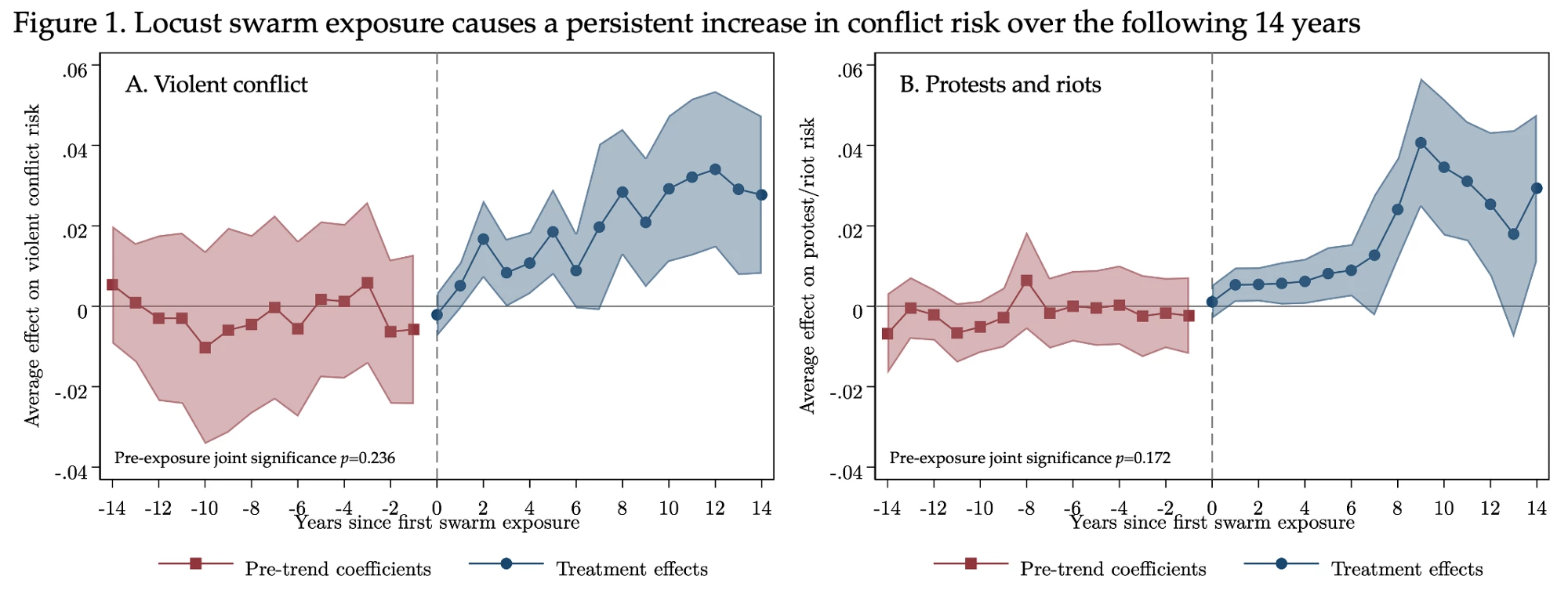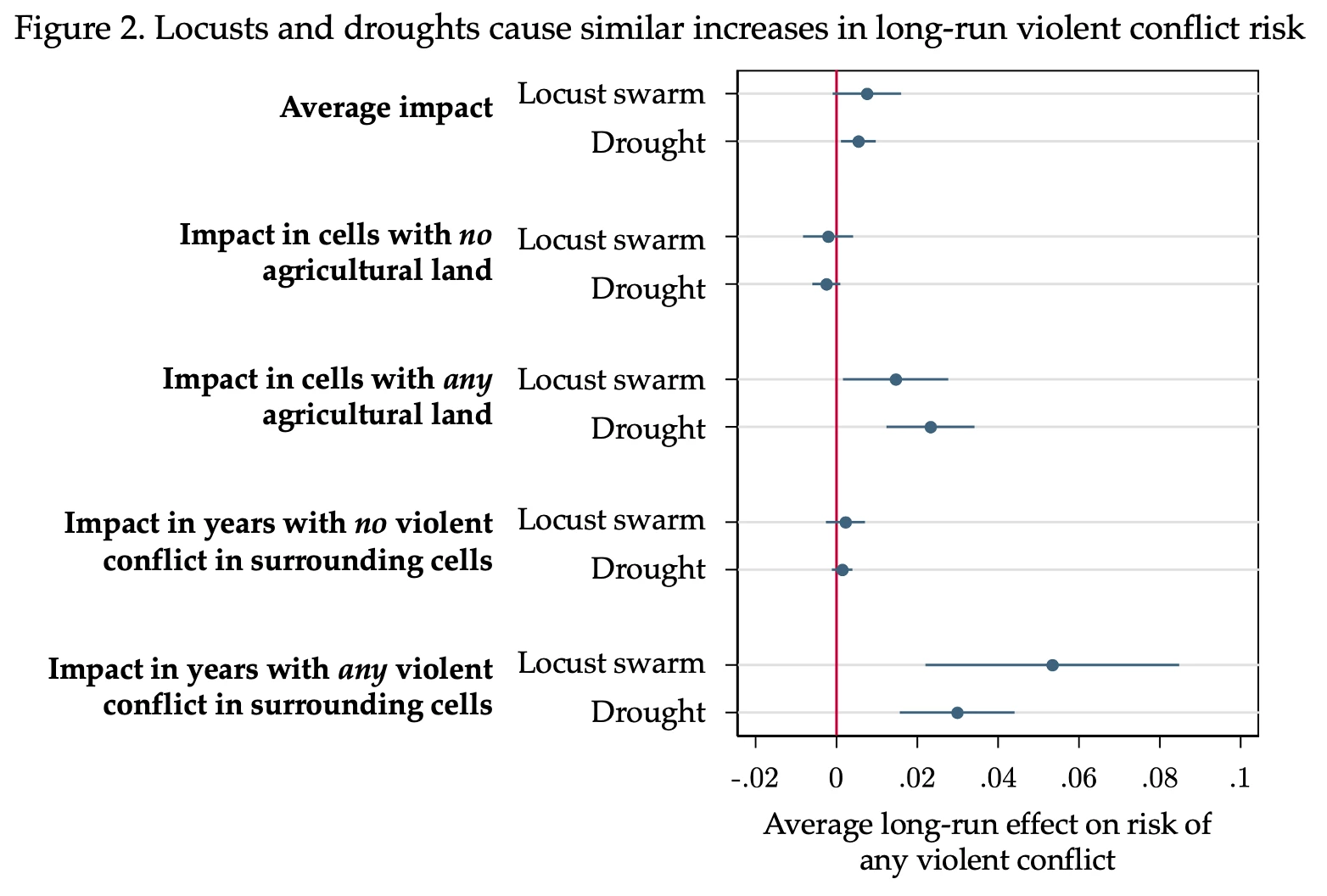This is the 16th in this year’s series of posts by PhD students on the job market.
Many studies have shown that transient agricultural shocks, such as fluctuations in weather (Harari & La Ferrara 2018) and global commodity (Dube & Vargas 2013) or food (McGuirk & Burke 2020) prices, affect the short-run risk of violent conflict. Seminal models focus on two main opposing mechanisms. First, reduced returns to agricultural labor when prices are low or during a drought means the opportunity cost of fighting is lower: producers have less to lose by engaging in conflict. At the same time, lower agricultural prices or output reduce the returns to predation: bandits or looters have less to gain from fighting. The evidence on shocks that temporarily reduce agricultural returns generally shows that the opportunity cost mechanism dominates, increasing short-run conflict risk.
In my job market paper I ask: what about the long run? While transient shocks do not directly affect land productivity and future returns to agriculture or to fighting, strategies to smooth consumption following an income shock can have long-term negative effects on household physical and human capital (de Janvry et al 2006). To the extent this wealth or permanent income mechanism makes affected households less productive in the long-run and reduces their opportunity cost of fighting, could a severe shock increase long-run conflict risk? I explore this by analyzing dynamic impacts of exposure to desert locust swarms on violent conflict across Africa and the Arabian Peninsula.
Analyzing impacts of locust swarm exposure
Desert locusts are a species of grasshopper native to desert areas from Mauritania to the Middle East. They are not a threat to agricultural production in most years, but in certain years their population explodes leading to the formation of extremely destructive swarms. Locust swarms are migratory and often include billions of locusts covering tens of square kilometers, consuming millions of kilograms of vegetation each day. Farmers have no defense and suffer massive damages to crops and pasture and severe food insecurity.

From an econometric perspective, desert locust swarms represent a catastrophic exogenous shock to agricultural production. Swarms regularly fly over 100km daily, typically downwind, without regard for particular kinds of vegetation. This creates local variation in exposure along their migratory paths in years when swarms form. I leverage this variation using methods from the recent literature on difference-in-differences that account for staggered treatment timing. The identifying assumption is that trends in conflict risk would have been similar over time in areas exposed to swarms and unaffected areas in the same country with similar rainfall, temperature, and population in the absence of locusts.
I analyze the local impacts of locust swarms on conflict from 1997-2018 for a sample of over 24,000 0.25 degree grid cells (28x28 km) in Africa and the Arabian Peninsula, using data from the FAO’s Locust Hub and the Armed Conflict Location & Event Data Project. I define locust swarm exposure as a permanent treatment starting from the first year a swarm is reported in a cell. Seven percent of cells were exposed to a locust swarm during the sample period, 72% of which were during the 2003-2005 upsurge that primarily affected West and North Africa.
Locust swarms increase long-run conflict risk
Figure 1 shows the event study results. I find no difference in the probability of any conflict event in the years prior to swarm exposure, supporting the parallel trends assumption, but significant and persistent increases in conflict risk afterward. Cells that were affected by a locust swarm are on average 2.1 percentage points more likely to experience any violent conflict each year afterward, with large effects even 14 years later (Panel A). I find similar impacts on the risk of protest and riot events (Panel B). These results are robust to a variety of alternative specifications.

In my preferred specifications I weight observations by the inverse of the estimated propensity to have been exposed to a locust swarm, so that comparisons are across cells with similar probabilities of exposure. The average effect including inverse propensity weights is a 0.8 percentage point increase in the risk of violent conflict each year following swarm exposure, driven by impacts in cells with agricultural land (Figure 2). This is a very large effect: a 43% increase in risk relative to the mean in similar areas without locust swarms.
What explains the increases in conflict risk?
The similar long-term effects on types of conflict with different objectives indicate that the mechanism is a persistent decrease in the opportunity cost of fighting. Using data from the AReNA DHS project covering 40 household surveys across 9 sample countries from 1992-2018, I find that swarm exposure decreases mean cereal yields in a cell by 108 kg/ha on average in subsequent years. This is a large effect (mean yields are 1987 kg/ha) and comparable to the 86 kg/ha decrease from a 1 degree Celsius temperature increase the same year.
Since locust swarms are transient and do not affect underlying land productivity, this long-term yield decrease suggests a permanent income or wealth effect of the initial income shock. The result is consistent with other studies finding persistent negative effects of locust swarms on farmers’ profits (Marending & Tripodi 2022) and on children’s educational attainment (de Vreyer et al 2014) and weight- and height-for-age (Conte et al 2023, Le & Nguyen 2022).
Figure 2 shows that swarm exposure only increases conflict risk in years when there is already violent conflict in the surrounding area. This suggests a lower cost of recruiting fighters to join armed groups in areas exposed to locust swarms when such groups emerge due to other proximate causes. The incidence of conflict in the sample countries was relatively low from 1997-2010 before increasing from 2011-2018 due to food price shocks, the Arab Spring, the spread of Islamic militant groups, and other factors. As most locust exposure in the sample occurred in 2004 and 2005, the heterogeneity in impacts by surrounding conflict explains why Figure 1 shows the largest effects of swarm exposure on conflict risk come after 7-14 years.

Is the impact of locust swarms on conflict unique?
Figure 2 compares average long-term impacts on violent conflict risk of exposure to locust swarms and to severe drought—defined as at least 4 consecutive months where the Standardized Precipitation and Evapotranspiration Index (SPEI) in the cell is below -1.5. The patterns are similar, with long-term increases in violent conflict risk following both swarm and drought exposure concentrated in agricultural cells and in years with violent conflict in the surrounding area. As a result, analyses estimating temporary effects of these shocks using fixed effects approaches—the most common method—underestimate the short-term impact on conflict risk. Future research on the impacts of transient economic shocks on conflict should account for the possibility of long-term effects in areas that cannot recover fully from the initial income loss.
Policy implications
Millions of small farm households in Africa are increasingly vulnerable to climate change, extreme weather events, input supply constraints, and food price volatility. The risk of increased violent conflict in the long run following agricultural shocks magnifies the importance of policies helping households to build resilience, smooth consumption, and recover livelihoods following such shocks. Climate change is also creating conditions more conducive to swarm formation, potentially undoing progress from international monitoring and control efforts in recent decades. Increased coordination and investment in proactive locust monitoring and control will have larger benefits than previously considered by preventing long-run increases in conflict.
Pierre Biscaye is a PhD candidate in Agricultural and Resource Economics at the University of California at Berkeley. Learn more about his research at www.pierrebiscaye.com.


Join the Conversation